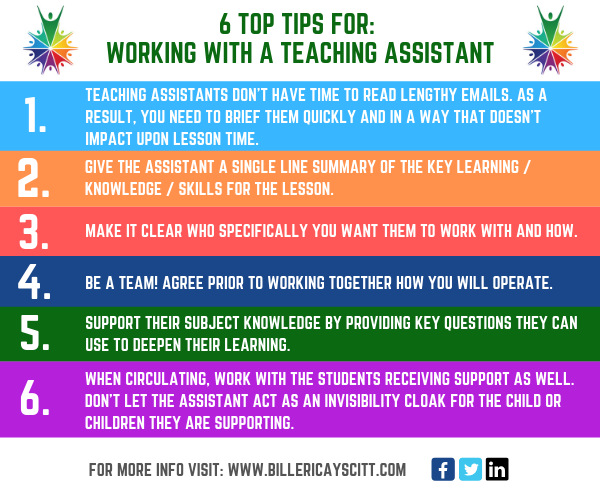The Learning Support Assistant (LSA) / Teaching Assistant (TA) is the most expensive resource in the classroom, apart from you of course! It is therefore really important that if you are lucky enough to have one in a class with you, you deploy them effectively. (Teaching standards 5 and 8)
Here are 6 top tips for working with a teaching assistant:
- Teaching assistants don’t have non-contact time or time to read lengthy emails; most will not be subject specialists. As a result, you need to brief them quickly and in a way that doesn’t impact lesson time.
- Give the support assistant a single-line summary of the key learning/knowledge/skills for the lesson. E.g. Evaluate – Which monarch was most to blame for the French Revolution: Louis xiv, Louis xv or Louis xvi? Try a post-it note rather than risking an email that might be missed.
- Make it clear who specifically you want the LSA / TA to work with and how? Your starting point should always be your pupil’s passports; use whatever else you know about the child from having taught them in your subject. For example Cara – repeat the instructions for tasks. Bring her back on task when she loses concentration. Get her to verbalise her answer to you before the feedback. Try a support logbook that you give to the assistant at the start of the lesson. This would allow the learning support assistant to make notes during the lesson about the foci in case you don’t get time to speak at the end.
- Be a team! Agree prior to working together on how you will operate. For example, if you have given the first warning, is the next warning given by the assistant another first warning or a second warning? (Remember – poor behaviour is often part of a bigger SEMH issue. What strategies have you agreed for specific individuals?) Do you want the LSA not to talk whilst you are explaining to the class? Try to touch base with your LSA / TA regularly during the lesson. Monitor and review intervention strategies.
- Support their subject knowledge. For example, don’t assume they will know key subject terminology or the correct answers. Try providing key questions that the LSA can use to deepen learning as they work with individuals or keywords that they should be developing an understanding of.
- When circulating, work with the students receiving support as well. Don’t let the teaching assistant act as an invisibility cloak for the child they are supporting. Inclusion is not just about the students being in the room. Try asking the LSA to work with another pupil whilst you work with a supported student. After a quick RAG or thumbs up/down, direct the LSA to some of the unsure pupils whilst you intervene with the others.
Other ways the LSA can support learning:
- Pupil organisation; recording homework; as a talk partner; as a scribe; sharing detailed knowledge of the student in other lessons.
- Finally, remember that you should be evaluating your deployment of the LSA. How effective are the interventions in promoting independence and autonomy?
Billericay SCITT provides an outstanding Teacher Training programme in Essex If you are interested in training to teach or know someone that is, visit us in person at one of our information events!



